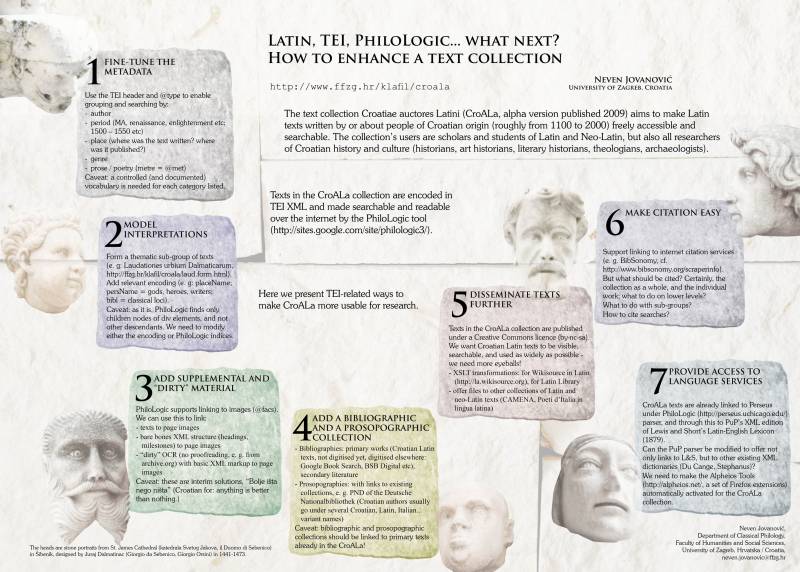Latin, TEI, PhiloLogic... what next? Enhancing a text collection
A poster presented at The 2010 Conference and Members’ Meeting of the Text Encoding Initiative Consortium, Zadar, Croatia
Neven Jovanović
CROSBI entry for this work.
The text collection Croatiae auctores Latini (CroALa, http://www.ffzg.unizg.hr/klafil/croala, first version published 2009) makes freely accessible Latin texts written by or about people of Croatian origin from the Middle Ages to the twentieth century. The collection's users are primarily scholars of Latin and Neo-Latin, as well as of Croatian history and culture. Texts in the CroALa collection are encoded in TEI XML and made searchable and readable over the internet by the PhiloLogic tool.
The next step in developing the collection is to turn it into an advantageous resource for the scholarly commnity. To achieve this, the collection has to prove itself as a basis for serious research. What can be done (besides adding more texts) to stimulate such research?
The poster outlines and illustrates seven ways in which the CroALa collection is at the moment being made more useful for scholarship, both traditional and digital. The technical solutions by which these enhancements are achieved will also be presented.
The seven enhancement strategies are:
- modelling interpretation by adding thematic encoding to a sub-group of texts
- fine-tuning the metadata and PhiloLogic to enable grouping by author, period, genre, theme
- adding supplemental material (digital facsimiles, links to texts annotated by authors interesting for CroALa)
- enabling the existing TEI/Philologic setup to present bibliographies and similar finding aids (e. g. to Google Book Search)
- using TEI and XSLT to disseminate texts further (e. g. to Wikisource and other Neo-Latin text collections)
- accessing other language services (e. g. Alpheios tools, Perseus parser and dictionaries, or Johann Ramminger's Neulateinische Wortliste) from CroALa texts through PhiloLogic
- making citations easier via BibSonomy
The enhancements are realized mainly by XML encoding, XSLT stylesheets, PhiloLogic fine-tuning, and occassional one-liners of code. The solutions are simple and within reach of an advanced computer user (the presenter of this poster is certainly no programmer). However, we consider publishing and documenting these solutions as not altogether trivial. It can serve a pedagogical purpose, first by helping newcomers to find their way around the immense potential opened by the TEI encoding scheme, and then encouraging other humanities scholars to try on the roles of both users and makers (or, at least, adaptators) of TEI-based digital tools: “if I did it, you can do it too!”
